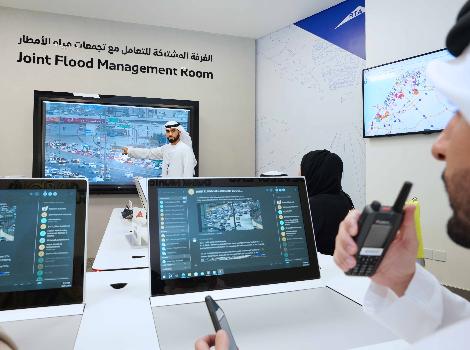Press Releases
14 Jan 2024
Launching “Joint Flood Management room” to address rainwater accumulations
(The room is managed through the Enterprise Control Centre )

Dubai’s Roads and Transport Authority (RTA) has launched a ‘Joint Flood Management Room’ at its Enterprise Command and Control Centre (EC3), one of the largest and most sophisticated control centres, to address water accumulation during heavy rain, monitor and manage traffic and various transport modes. The Joint Room was launched in collaboration with strategic partners: Dubai Police General Headquarters, Dubai Municipality, Mohammed Bin Rashid Housing Establishment, and representatives from main development areas. The room uses the latest technologies to monitor response plans, and distribute onsite teams, and resources allocation to address the water accumulation during heavy rain impacting the road and traffic across the emirate.
This move undertaken in collaboration with stakeholders, reflects RTA’s commitment to implementing the leadership's directives to enhance Dubai's position as one of the world's smartest cities, improve the level of services and smooth mobility, and ensure the safety and security of all road users.
In coordination with the National Centre of Meteorology, RTA seeks to improve the collection of information on weather forecasts and rain enhancement in Dubai proactively and accurately. This will step up the preparedness of the RTA and relevant teams to cope with water accumulations during heavy rain and broadcast informative and warning messages to the public, especially road users.
RTA formed a supervisory team with representatives from various entities, such as Dubai Police General Headquarters, Dubai Municipality, Mohammed Bin Rashid Housing Establishment, and representatives from main development areas, to prepare a comprehensive response plan to deal with weather fluctuations and insure proactive readiness for the monsoons. RTA also employed several technologies to enhance response effectiveness and improve recovery time for water accumulations resulting from heavy rain on major roads across Dubai. Examples include:
- Heat Map (GIS Map) Illustrating identified areas of water accumulations, in addition to the locations indicating pump sites and resources belonging to participating entities.
- Video Wall Screen displaying live footage from 450 surveillance cameras covering 91% of the identified areas with rainwater ponds on the main roads of the city.
- CITADEL Communication Platform providing necessary real-time information to supervisory and field teams about the status of ongoing actives.
- Mobile Command Vehicle (MCV) equipped with surveillance cameras connected to the control room, which can be directed to cover areas not monitored by surveillance cameras.
The Joint Room has contributed to proactive preparations for the rainy season, fostering collaboration among partners and centralising information. This has resulted in faster decision-making regarding the deployment of teams and resources, leading to a 36% improvement in response and recovery time compared to the previous period.
RTA is keen on delivering information and warning messages to the public through its digital channels over two phases: Proactive Messages based on information from the National Centre of Meteorology, highlighting the need for caution and safe driving for road users via social media for their safety. The second phase relates to the rainy period using warning messages to the public via social media about the impact of weather conditions on the road network and transportation means. Immediate warnings for drivers are also displayed via dynamic message signs on major roads in Dubai.
Dedicated to handling water accumulations during heavy rain, the Joint Room operates under the Enterprise Command and Control Centre, which manages a transportation network comprising roads spanning more than 8,000 km. The centre features a central control room fitted with a 53-square-meter giant screen connected to 34 technical devices enabling real-time integration. Moreover, the EC3 can process feeds from more than 7,000 surveillance cameras and use artificial intelligence in managing incidents and crises. It also uses mobile phone data for planning, managing mobility and crowd control.
